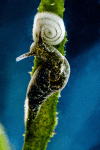Kleptoplasty: Getting away with stolen chloroplasts
- PMID: 36346789
- PMCID: PMC9642861
- DOI: 10.1371/journal.pbio.3001857
Kleptoplasty: Getting away with stolen chloroplasts
Abstract
Kleptoplasty, the process by which a host organism sequesters and retains algal chloroplasts, is relatively common in protists. The origin of the plastid varies, as do the length of time it is retained in the host and the functionality of the association. In metazoa, the capacity for long-term (several weeks to months) maintenance of photosynthetically active chloroplasts is a unique characteristic of a handful of sacoglossan sea slugs. This capability has earned these slugs the epithets "crawling leaves" and "solar-powered sea slugs." This Unsolved Mystery explores the basis of chloroplast maintenance and function and attempts to clarify contradictory results in the published literature. We address some of the mysteries of this remarkable association. Why are functional chloroplasts retained? And how is the function of stolen chloroplasts maintained without the support of the algal nucleus?
Copyright: © 2022 Cruz, Cartaxana. This is an open access article distributed under the terms of the Creative Commons Attribution License, which permits unrestricted use, distribution, and reproduction in any medium, provided the original author and source are credited.
Conflict of interest statement
The authors have declared that no competing interests exist.
Figures



References
-
- Rumpho ME, Dastoor FP, Manhart JR, Lee J. The kleptoplast. In: Wise RR, Hoober JK, editors. Advances in photosynthesis and respiration: the structure and function of plastids, Vol. 23. Springer; 2007. p. 451–473. 10.1007/978-1-4020-4061-0_23 - DOI
Publication types
MeSH terms
LinkOut - more resources
Full Text Sources

